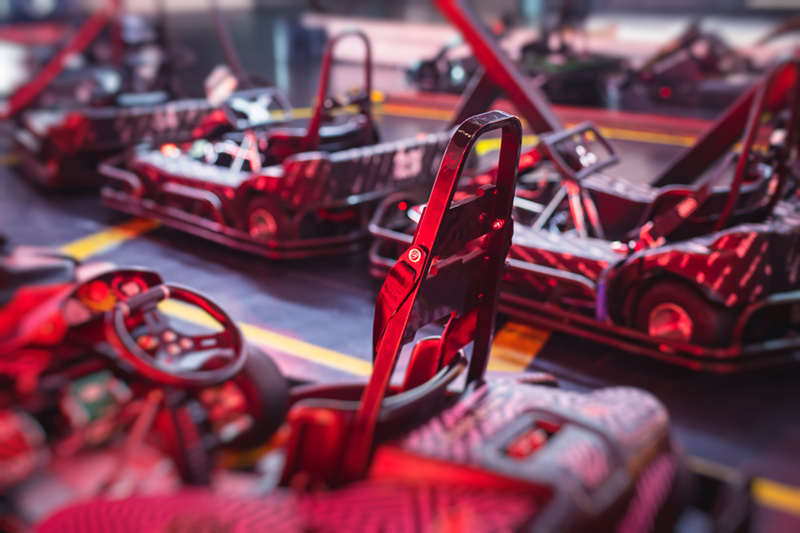Go kart rental risks and liabilities
While go kart racing is a relatively safe activity, it does come with specific risks and liabilities. According to a ten-year study by the Consumer Protection Agency, an average of 10,500 injuries come from go kart accidents. Fortunately, go kart fatalities are exceedingly rare, numbering in the low hundreds each year—however, they do occur.
Accidents and deaths from go kart racing can expose track owners to costly litigation and negative PR. In a high-profile case from 2019, a family sued a raceway after their son passed away from a complication due to a go kart accident.
According to the same report from the Consumer Protection Agency, most go kart accidents are caused by colliding with another kart or stationary object, loss of stability, and inexperienced drivers. Raceway owners and operators can minimize the risks or related injuries by understanding the most common causes of injuries, maintaining safety standards, and enforcing track rules.
Common causes of go kart accidents and associated injuries
Causes of go kart accidents include:
- Inexperienced drivers – Most go kart injuries involve drivers under the age of 15.
- Track conditions – Oil spills or other hazards may cause drivers to lose control. Many tracks do not have the latest safety features, such as collapsible barriers.
- Weather – Rain, snow, or sleet may cause unsafe track conditions.
- Mechanical failure – Improperly maintained go karts can fail and cause accidents.
- Long, unsecured hair – Hair that is improperly secured may become tangled or caught in the car while it’s in motion.
Common go kart injuries include:
- Whiplash.
- Sprains.
- Bone fractures.
- Burns.
- Head or abdominal trauma or bruising.
Learn more: Amusement Park Accessibility: The Importance of ADA Compliance
Maintaining safety standards
Maintaining safety standards for the karts and the track will minimize risk.
Proper maintenance of the fleet
Mechanical failure is a common cause of accidents. For example, brake failure, broken speed governors, or engine failure can cause serious crashes. Fortunately, raceway operators can take a few simple steps to keep karts running smoothly:
- Schedule regular maintenance and quality checks for all karts. These checks should monitor tire pressure, oil levels (if using an internal combustion model), battery life and levels (especially if using an electric model), and safety harnesses.
- Regularly retire and replace aging kart models.
Maintaining optimal track conditions
Track owners should regularly invest in the latest safety equipment, such as collapsible barriers. Operators should take the following steps to maintain optimum track safety:
- Regularly repair potholes, cracks, or other wear to the track.
- Take extensive accident reports and review for patterns. Is there one turn that is too sharp for some riders?
- Monitor weather conditions closely and shut down the track immediately in the case of rain, snow, lighting, or other hazardous conditions.
Learn more: Three Simple Strategies to Reduce Slip, Trip, and Fall Claims
Enforcing track rules and avoiding go kart accidents
Many go kart accidents are the result of horseplay and ignoring track rules, which is why it’s vital for staff to have in-depth safety training and to enforce the rules. Other go kart accidents occur because of improper clothing or inadequate safety equipment. One notable incident from 2015 ended with a woman in a vegetative state for years before her ultimate death. The cause? Her scarf caught in the go-kart’s exposed axle and choked her. This tragedy would have been prevented if the raceway staff had asked her to remove the scarf before racing.
Staff should also train in maintaining the following standards:
- First, ensure that all guests sign liability waivers before racing. While not bulletproof against all forms of liability (owners would still be liable in a case of gross negligence, for example), a waiver is a valuable tool in mitigating risk.
- Review safety protocols with each batch of racers before they begin.
- Make sure racers remove loose-fitting clothing, jewelry, and any other item that could potentially catch in the wheels, axle, or steering wheel.
- Confirm that all drivers wear proper safety equipment, such as face-covering helmets, and that safety harnesses are secure before getting on the course.
For most commercial tracks, a good helmet and a secure harness are the essentials in terms of equipment. But for faster professional racers, other advanced safety gear may be required to ensure rider safety and comfort. Examples of advanced equipment include:
- Gloves.
- Kart Suit.
- Kart Shoes.
- Neck Brace.
- Rib protector.
Minimizing go kart track liability
Most go kart accidents are preventable. By understanding the most common causes of injuries, maintaining safety standards, and enforcing track rules, track owners and operators can significantly reduce the risk of guest fatalities and costly litigation. Despite raceway owners’ best efforts, accidents can still happen.
A vital, often overlooked, safety step is to review insurance coverage. Despite the best of intentions, go kart accidents happen frequently, and your company can be caught in the crosshairs of a costly lawsuit without proper coverage. McGowan Allied Specialty Insurance has over 35 years of experience servicing the amusement and entertainment sector with our highly customizable specialty insurance products. Our priority is to help our clients meet their goals through outstanding customer service and unparalleled support.
Contact us today at 727-353-6230 for more information about our comprehensive amusement and entertainment insurance coverage options.
